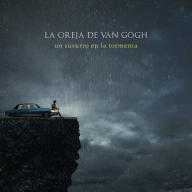La Oreja de Van Gogh formed in 1996 after guitarist Pablo Benegas, bassist Álvaro Fuentes, keyboardist Xabi San Martín, and drummer Haritz Garde met at a local university. Vocalist Amaia Montero joined the band following an invitation from Benegas, whom she'd met at a dinner party. From the outset, San Martín, Benegas, and Montero have served as the band's primary songwriters.
Signed by Sony Discos, La Oreja de Van Gogh debuted in 1998 with Dile al Sol, which spawned several hit singles -- including "El 28" and "Cuentame al Oido" -- and earned the band an Ondas Award for Best New Act. Their second album, 2000's El Viaje de Copperpot (2000), fared similarly; this time, however, singles like "Cuídate" and "La Playa" registered on an international level, charting in Latin America and the United States. Lo Que Te Conté Mientras Te Hacías la Dormida (2003) continued the band's success; eight singles from the album charted in Spain, four of them reaching number one, and the group continued to break into the Latin American markets, including the States. While La Oreja de Van Gogh were no strangers to success by this point, Lo Que Te Conté Mientras Te Hacías la Dormida proved to be their breakout album in many ways. For one, they toured heavily behind it, as documented on the 2004 concert DVD En Directo: Lo Que Te Conté Mientras Te Hacias la Dormida. Secondly, they won several awards in the wake of the album, including an Ondas Award for Best Album and an MTV Latin Award for Best Group. Finally, it was their first album to sell impressively in the Americas, with over 100,000 copies sold in the States alone.
La Oreja de Van Gogh commemorated their tenth anniversary with the release of Guapa in 2006. Their most dynamic album yet, with notably surging guitar and more extensive use of keyboards, Guapa nonetheless measured up to their past successes; its first two singles, "Muñeca de Trapo" and "Dulce Locura," were chart-toppers in Spain, while the album itself reached number five on the Top Latin Albums chart in the States, the band's highest peak yet. Furthermore, Guapa won the band a Latin Grammy for Best Pop Album by a Duo or Group with Vocals. In December 2006, a special double-disc edition of the album, Más Guapa, was released in Spain, containing numerous unreleased tracks and demos. Amaia Montero left the group in 2007, hoping to launch a solo career, and La Oreja de Van Gogh found a replacement vocalist in Leire Martínez. The new lineup returned to the studio and emerged with their fifth album, 2008's A las Cinco en el Astoria, which quickly earned platinum status in Spain. To cement Martínez’s position in the band, 2009 saw the release of Nuestra Casa a la Izquierda del Tiempo, which featured re-recordings of La Oreja de Van Gogh's older material. In 2011, the band re-entered the studio with producer Simon Nordberg to record their sixth studio album, Cometas por la Cielo. While touring in support, the band's label issued the compilation Dos Clásicos in 2012, and followed it with the live album Primera Fila in 2013. The latter was produced by Áureo Baqueiro. La Oreja de Van Gogh booked him again when they re-entered the studio at the beginning of 2016. The pre-release single "Verano" charted in Spain in the fall. The full-length El Planeta Imaginario was issued in November. It placed in the Top Ten on the Hot Latin albums charts internationally and landed in the top spot on Spain's best-selling albums list.
In the winter of 2020, the band returned to the studio with producer Paco Salazar. In April they issued the video single "Abrázame," which garnered more than ten million views and topped the streaming charts. The full-length Un Susurro en la Tormenta was released by Sony Music in September. It peaked in the top spot on the Spanish album charts and reached number one at streaming in six Latin American countries. ~ Jason Birchmeier & Thom Jurek, Rovi


















